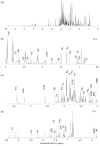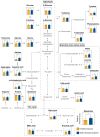NMR-Based Metabolomic Analysis of Biotic Stress Responses in the Traditional Korean Landrace Red Pepper (Capsicum annuum var. annuum, cv. Subicho)
- PMID: 39337392
- PMCID: PMC11432352
- DOI: 10.3390/ijms25189903
NMR-Based Metabolomic Analysis of Biotic Stress Responses in the Traditional Korean Landrace Red Pepper (Capsicum annuum var. annuum, cv. Subicho)
Abstract
Korean landrace red peppers (Capsicum annuum var. Subicho), such as the traditional representative Subicho variety, are integral to Korean foods and are often consumed raw or used as a dried powder for cuisine. However, the known vulnerability of local varieties of landrace to biotic stresses can compromise their quality and yield. We employed nuclear magnetic resonance (NMR) spectroscopy coupled with a multivariate analysis to uncover and compare the metabolomic profiles of healthy and biotic-stressed Subicho peppers. We identified 42 metabolites, with significant differences between the groups. The biotic-stressed Subicho red peppers exhibited lower sucrose levels but heightened concentrations of amino acids, particularly branched-chain amino acids (valine, leucine, and isoleucine), suggesting a robust stress resistance mechanism. The biotic-stressed red peppers had increased levels of TCA cycle intermediates (acetic, citric, and succinic acids), nitrogen metabolism-related compounds (alanine, asparagine, and aspartic acid), aromatic amino acids (tyrosine, phenylalanine, and tryptophan), and γ-aminobutyric acid. These findings reveal the unique metabolic adaptations of the Subicho variety, underscoring its potential resilience to biotic stresses. This novel insight into the stress response of the traditional Subicho pepper can inform strategies for developing targeted breeding programs and enhancing the quality and economic returns in the pepper and food industries.
Keywords: Capsicum annuum; NMR; Subicho; biotic stress; metabolomics; red pepper; stress resistance.
Conflict of interest statement
The authors declare no conflicts of interest.
Figures





References
-
- Duranova H., Valkova V., Gabriny L. Chili peppers (Capsicum spp.): The spice not only for cuisine purposes: An update on current knowledge. Phytochem. Rev. 2022;21:1379–1413. doi: 10.1007/s11101-021-09789-7. - DOI
-
- Barik S., Ponnam N., Reddy A.C., Reddy D.C.L., Saha K., Acharya G.C., Reddy K.M. Breeding peppers for industrial uses: Progress and prospects. Ind. Crop. Prod. 2022;178:114626. doi: 10.1016/j.indcrop.2022.114626. - DOI
-
- Yun S., Kim H. Insight into the phylogenetic relationships and evolutionary history of pepper cultivars (Capsicum annuum L.) through comparative analyses of plastomes. Horticulturae. 2023;9:1092. doi: 10.3390/horticulturae9101092. - DOI
MeSH terms
Substances
Grants and funding
LinkOut - more resources
Full Text Sources

